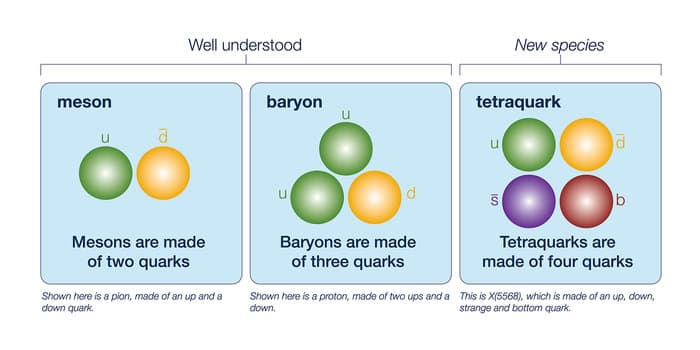Exotic “Four Flavored” Tetraquark Discovered
A group of physicists from Indiana University has recently discovered a new type of elementary particle, the "four-flavoured" tetra quark. Daria Zieminska, the team leader delivered the first scientific presentation on their current research emphasizing on the detection methodology of tetra quarks adopted in Fermilab.
The standard model of particle physics dictates that all hadrons either consist of a quark and antiquark pair(mesons) or three quarks(baryons). However, this fundamental breakthrough proves that a tetra quark system can also exist in a special arrangement comprising two quarks and two antiquarks.
This pioneering discovery would further strengthen the understanding of quark matter or QCD (the modern theory of strong interaction) matter, which are theoretical phases that occur at extremely high temperatures and densities equivalent to what was experienced during moments after big bang and which might still exist at the core of neutron stars, strangelets and cosmic ray impacts.

Quarks Existence
Quarks are fundamental particles which combine to form composites called hadrons that are held together by the strong nuclear force, one of the four fundamental forces of nature. The most stable among such hadrons are the well-known constituents of the atomic nucleus, protons and neutrons.
There as total six types or “flavours†associated with quarks namely up, down, strange, charm, bottom and top, each having an antimatter counterpart. As the name suggests, a tetra quark symbolizes a stable group of four quarks, and was detected for the first time in 2008. However, the unique attribute of the latest discovery lies in the co-existence of four different flavours of quarks i.e. up, down, strange and bottom.
The groundbreaking research was undertaken by means of the DZero experiment, in which Zieminska was in-charge of "heavy flavour" group. Though the quadruple arrangement of quarks does not defy the laws of physics, they are very rare and poorly understood. In the near future, the team wants to validate the existence of the new particle by measuring its decay rate and spin rate against its axis. Once the existence of the new type of particle is confirmed, the task will be to incorporate it in the Standard Model. The complete research work was published in the Physics Review Letters journal.
Source: #-Link-Snipped-#
The standard model of particle physics dictates that all hadrons either consist of a quark and antiquark pair(mesons) or three quarks(baryons). However, this fundamental breakthrough proves that a tetra quark system can also exist in a special arrangement comprising two quarks and two antiquarks.
This pioneering discovery would further strengthen the understanding of quark matter or QCD (the modern theory of strong interaction) matter, which are theoretical phases that occur at extremely high temperatures and densities equivalent to what was experienced during moments after big bang and which might still exist at the core of neutron stars, strangelets and cosmic ray impacts.

Quarks Existence
Quarks are fundamental particles which combine to form composites called hadrons that are held together by the strong nuclear force, one of the four fundamental forces of nature. The most stable among such hadrons are the well-known constituents of the atomic nucleus, protons and neutrons.
There as total six types or “flavours†associated with quarks namely up, down, strange, charm, bottom and top, each having an antimatter counterpart. As the name suggests, a tetra quark symbolizes a stable group of four quarks, and was detected for the first time in 2008. However, the unique attribute of the latest discovery lies in the co-existence of four different flavours of quarks i.e. up, down, strange and bottom.
The groundbreaking research was undertaken by means of the DZero experiment, in which Zieminska was in-charge of "heavy flavour" group. Though the quadruple arrangement of quarks does not defy the laws of physics, they are very rare and poorly understood. In the near future, the team wants to validate the existence of the new particle by measuring its decay rate and spin rate against its axis. Once the existence of the new type of particle is confirmed, the task will be to incorporate it in the Standard Model. The complete research work was published in the Physics Review Letters journal.
Source: #-Link-Snipped-#
0
